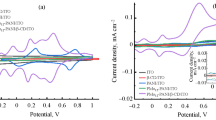Abstract
A novel polyaniline (PAni) coated optical fiber sensor with Mach-Zehnder interferometers (MZI) configuration was developed to overcome the pitfalls of conventional sensing methods such as atomic absorption spectrometry (AAS), and anodic stripping voltammetry (ASV) in Pb detection. PAni with different Ani to AOT mixture ratios (5 : 3, 5 : 5, and 5 : 7) and different types of acid dopants (HCl, H2SO4 and H3PO4) were synthesized using chemical oxidation reaction. The emeraldine-salt form of PAnis was confirmed by FTIR and UV–Vis spectra. All the produced PAnis showed electrical conductivity from 4.5 × 10–3 to 4.2 × 10–1 S/cm. Among all PAnis, PAni-HCl possessed the highest electrical conductivity (4.2 × 10–1 S/cm) due to the low pH of HCl which provided more mobile carbocation. For sensor application, PAni-H2SO4 coated optical fiber sensor showed the best performance with the highest sensitivity of 0.0927 nm/ppm, fast response time of 11 s and limit of detection (LOD) of 30 ppm. The performance of this PAni-coated optical sensor is better than conventional methods with longer response time of 3 min and LOD of 5 ppm in Pb detection. This is due to the two steps dissociations of H2SO4 which can protonate larger amount of amine and imine groups along the PAni backbone to yield more active sites, which leads to the improvement in Pb detections. It is postulated that the mechanism of Pb detection is based on a bonding interaction that occurs between the Pb2+ cation and the double bond of N from the imine groups of PAni. Supporting data from FTIR, UV–Vis and electrical conductivity studies have confirmed the chemical interaction between PAni and Pb.






Similar content being viewed by others
REFERENCES
M. Ardalani, M. Shamsipur, and A. Besharati-Seidani, J. Electroanal. Chem. 879, 114788 (2020).
A. Baysal, N. Ozbek, and S. Akman, in Waste Water. Treatment Technologies and Recent Analytical Developments, Ed. By F. S. G. Einschlag (IntechOpen, Rijeka, 2013), pp. 146−165.
B. H. Lee, Opt. Fiber Technol. 9, 57 (2003).
Y. S. Chiam, K. S. Lim, S. W. Harun, S. N. Gan, and S. W. Phang, Sens. Actuators, A. 205, 58 (2014).
D. J. Gentleman and K. S. Booksh, Talanta 68, 504 (2006).
B. H. Lee, Y. H. Kim, K. S. Park, J. B. Eom, M. J. Kim, B. S. Rho, and H. Y. Choi, Sensors 12, 2467 (2012).
A. Lokman, H. Arof, and S. W. Harun, Measurement 59, 167 (2015).
H. Huang, W. C. Zhu, X. C. Gao, X. Y. Liu, and H. Y. Ma, Anal. Chim. Acta 947, 32 (2016).
K. M. Molapo, P. M. Ndangili, R. F. Ajayi, G. Mbambisa, S. M. Mailu, N. Njomo, M. Masikini, P. Baker, and E. I. Iwuoha, Int. J. Electrochem. Sci. 7, 11859 (2012).
W. Wang, X. Xie, and S. He, Sensors 13, 16816 (2013).
M. Eising, C. E. Cava, R. V. Salvatierra, A. J. G. Zarbin, and L. S. Roman, Sens. Actuators, B 245, 25 (2017).
A. Soleymanpour and S. A. Rezvani, Sens. Actuators, B 247, 602 (2017).
M. O. Munyati, A. Mbozi, M. N. Siamwiza, and M. M. Diale, Synth. Met. 233, 79 (2017).
G. A. ter Boo, D. W. Grijpma, R. G. Richards, T. F. Moriarty, and D. Eglin, Clin. Hemorheology Microcirc. 60, 89 (2015).
Y. S. Chiam, I. Z. M. Ahad, S. W. Harun, S. N. Gan, and S. W. Phang, Synth. Met. 211, 132 (2016).
K. P. Sambasevam, S. Mohamad, and S. W. Phang, Mater. Sci. Semicond. Process. 33, 24 (2015).
D. W. Hatchett, M. Josowicz, and J. Janata, J. Phys. Chem. B 103, 10992 (1999).
Z. W. Yang, D. H. Coutinho, R. Sulfstede, K. J. Balkus, Jr., and J. P. Ferraris, J. Membr. Sci. 313, 86 (2008).
Acids—pH Values’ in Engineering ToolBox 2003. https://www.engineeringtoolbox.com/acids-ph-d_401.html. Cited 2021.
M. Hagen and J. Järnberg, “140. Sulphuric, Hydrochloric, Nitric and Phosphoric Acids,” in The Nordic Expert Group for Criteria Documentation of Health Risks from Chemicals (University of Gothenburg, Gothenburg, 2009), p. 3.
I. Z. M. Ahad, S. W. Harun, S. N. Gan, and S. W. Phang, Sens. Actuators, B 261, 97 (2018).
T. V. Freitas, E. A. Sousa, G. C. Fuzari Jr., and E. P. S. Arlindo, Mater. Lett. 224, 42 (2018).
B. Butoi, A. Groza, P. Dinca, A. Balan, and V. Barna, Polymers 9, 732 (2017).
C. Dhivya, S. Anbu Anjugam Vandarkuzhali, and N. Radha, Arab. J. Chem. 12, 3785 (2019).
K. Y. Li and D. F. Xue, J. Phys. Chem. 110, 11332 (2006).
N. Colak and B. Sokmen, Des. Monomers Polym. 3, 181 (2000).
M. Ahmad Mir, M. Ahmad Bhat, S. Abdul Majid, S. H. Lone, M. Ahmad Malla, K. R. Tiwari, A. Hussain Pandit, R. Tomar, and R. Ahmad Bhat, J. Environ. Chem. Eng. 6, 1137 (2018).
G. D. Zhu, Y. X. Ge, Y. Dai, X. H. Shang, J. M. Yang, and J. Y. Liu, Electrochim. Acta 268, 202 (2018).
Funding
The authors would like to show gratitude for the financial support of this research by Tunku Abdul Rahman University College and the optical sensors were supplied by Universiti Tunku Abdul Rahman.
Author information
Authors and Affiliations
Corresponding author
Ethics declarations
The authors declare that they have no conflict of interest.
Rights and permissions
About this article
Cite this article
Jing-Yi Ong, Law, ZJ., Pua, CH. et al. Effect of Acid Dopants Toward Polyaniline Based Optical Sensor for Lead Detection. Polym. Sci. Ser. A 63, 485–492 (2021). https://doi.org/10.1134/S0965545X21050102
Received:
Revised:
Accepted:
Published:
Issue Date:
DOI: https://doi.org/10.1134/S0965545X21050102




